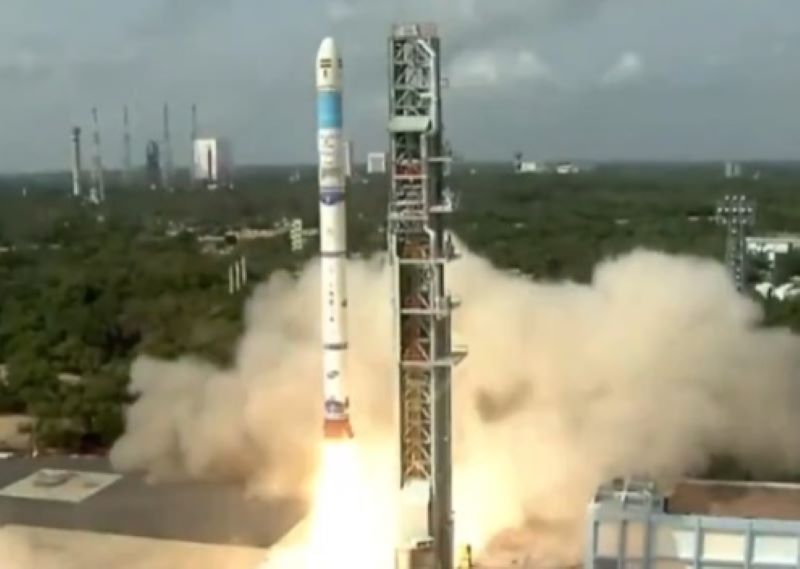 ISRO
ISRO
ISRO places Earth Observation Satellite successfully into orbit
The Indian Space Research Organisation (ISRO) scripted one more success story when it launched Earth Observation Satellite EOS-8 and a passenger satellite using the Small Satellite Launch Vehicle (SSLV) from the Spaceport of Sriharikota on Friday.
"The third developmental flight of SSLV is successful. The SSLV-D3 placed EOS-08 precisely into the orbit," ISRO posted on X.
SSLV-D3/EOS-08 Mission:
— ISRO (@isro) August 16, 2024
✅The third developmental flight of SSLV is successful. The SSLV-D3 🚀placed EOS-08 🛰️ precisely into the orbit.
🔹This marks the successful completion of ISRO/DOS's SSLV Development Project.
🔸 With technology transfer, the Indian industry and…
"This marks the successful completion of ISRO/DOS's SSLV Development Project," the Indian space body said.
What are the primary objective of the mission?
The primary objectives of the EOS-08 mission include designing and developing a microsatellite, creating payload instruments compatible with the microsatellite bus, and incorporating new technologies required for future operational satellites.
Kudos team #ISRO for the successful launch of SSLV-D3/EOS-08 Mission. With the personal intervention & patronage provided by PM Sh @narendramodi, Team @isro has been able to carry one success after the other in a serial manner. pic.twitter.com/9AJ5cgcNhq
— Dr Jitendra Singh (@DrJitendraSingh) August 16, 2024
Built on the Microsat/IMS-1 bus, EOS-08 carries three payloads: Electro Optical Infrared Payload (EOIR), Global Navigation Satellite System-Reflectometry payload (GNSS-R), and SiC UV Dosimeter.
The EOIR payload is designed to capture images in the Mid-Wave IR (MIR) and Long-Wave IR (LWIR) bands, both during the day and night, for applications such as satellite-based surveillance, disaster monitoring, environmental monitoring, fire detection, volcanic activity observation, and industrial and power plant disaster monitoring.
The GNSS-R payload demonstrates the capability of using GNSS-R-based remote sensing for applications such as ocean surface wind analysis, soil moisture assessment, cryosphere studies over the Himalayan region, flood detection, and inland waterbody detection.
Meanwhile, the SiC UV Dosimeter monitors UV irradiance at the viewport of the Crew Module in the Gaganyaan Mission and serves as a high-dose alarm sensor for gamma radiation.
The spacecraft mission configuration is set to operate in a Circular Low Earth Orbit (LEO) at an altitude of 475 km with an inclination of 37.4°, and has a mission life of 1 year.
The satellite has a mass of approximately 175.5 kg and generates power of around 420 W. It interfaces with the SSLV-D3/IBL-358 launch vehicle.
ISRO sais EOS-08 marks a significant advancement in satellite mainframe systems such as an Integrated Avionics system, known as the Communication, Baseband, Storage, and Positioning (CBSP) Package, which combines multiple functions into a single, efficient unit.
This system is designed with cold redundant systems using commercial off-the-shelf (COTS) components and evaluation boards, supporting up to 400 Gb of data storage.
Additionally, the satellite includes a structural panel embedded with PCB, an embedded battery, a Micro-DGA (Dual Gimbal Antenna), an M-PAA (Phased Array Antenna), and a flexible solar panel, each serving as key components for onboard technology demonstration.
Support Our Journalism
We cannot do without you.. your contribution supports unbiased journalism
IBNS is not driven by any ism- not wokeism, not racism, not skewed secularism, not hyper right-wing or left liberal ideals, nor by any hardline religious beliefs or hyper nationalism. We want to serve you good old objective news, as they are. We do not judge or preach. We let people decide for themselves. We only try to present factual and well-sourced news.







